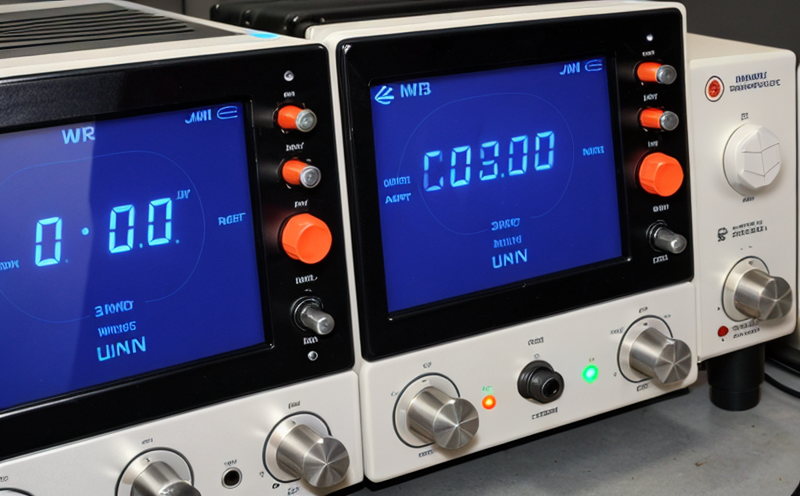EN 300 440 Short Range Device RF Communication Testing
The European standard EN 300 440 defines the technical requirements for radio equipment within the frequency range of 9KHz to 86GHz. This testing ensures compliance with EU regulations and standards for short-range devices like wireless sensors, remote controls, and IoT (Internet of Things) devices. The primary focus is on ensuring that these devices do not interfere with other licensed services or violate electromagnetic compatibility requirements.
Our comprehensive EN 300 440 testing covers a wide array of parameters including frequency bands, modulation types, power outputs, and interference characteristics. This service is crucial for manufacturers aiming to launch products in the European market as it ensures that devices meet stringent safety and performance criteria. The test setup includes state-of-the-art equipment such as spectrum analyzers, network analyzers, and software-defined radios (SDRs) which allow for precise measurement and analysis.
The process begins with a detailed review of product specifications to identify relevant frequency bands and modulation schemes. This is followed by thorough calibration of the test setup to ensure accurate measurements. Once calibrated, the device under test (DUT) undergoes rigorous testing across various parameters including frequency response, signal-to-noise ratio (SNR), adjacent channel interference, and compliance with EU safety directives such as RED (Radio Equipment Directive).
In addition to technical specifications, we also consider real-world usage scenarios. For instance, a smart thermostat might need to operate reliably in the presence of other household devices like cordless phones or Wi-Fi routers. Our tests simulate these environments to ensure robust performance and minimal interference. This approach not only meets regulatory requirements but also enhances product reliability and user satisfaction.
Environmental considerations play a significant role in our testing process. By ensuring that short-range devices operate efficiently without causing harm, we contribute positively to the environment by reducing energy consumption and minimizing electromagnetic pollution. The use of advanced test equipment allows us to identify areas where improvements can be made to enhance device efficiency further.
- Testing frequency bands from 9KHz to 86GHz
- Assessment of modulation types including FSK, GFSK, and ASK
- Evaluation of power outputs up to specified limits
- Detailed analysis of interference characteristics
Why It Matters
The importance of EN 300 440 testing cannot be overstated, especially in the context of smart home and IoT devices. These devices increasingly rely on wireless communication to function effectively, making them susceptible to interference from other electronic systems within homes or commercial spaces.
By adhering to this standard, manufacturers can ensure their products are safe for consumer use and do not pose risks such as fire hazards, health issues related to electromagnetic fields (EMFs), or privacy concerns. Compliance also helps in avoiding costly penalties and reputational damage associated with non-compliance.
From a broader perspective, ensuring compliance with EN 300 440 standards contributes significantly to the overall quality of life by promoting safer living environments. It ensures that devices work seamlessly together without causing disruptions or malfunctions. This is particularly important in homes where multiple connected devices are used simultaneously.
Moreover, manufacturers who comply with these regulations gain a competitive edge in the market. They demonstrate their commitment to delivering high-quality products that meet international standards, which can enhance brand reputation and customer trust. In today’s highly competitive marketplace, this added value is crucial for attracting customers and maintaining long-term relationships.
Benefits
The benefits of undergoing EN 300 440 short-range device RF communication testing extend beyond mere compliance. It offers several advantages that contribute to the overall success of your product:
- Regulatory Compliance: Ensures adherence to European standards and regulations, avoiding potential legal issues.
- Risk Mitigation: Identifies and rectifies potential problems early in the development process, reducing costs associated with rework or redesign.
- Enhanced Quality: Guarantees that your product meets high-quality standards, leading to better performance and reliability.
- Better User Experience: By ensuring seamless operation of connected devices, user satisfaction improves significantly.
- Innovation Support: Provides valuable insights into improving design for future products.
These benefits collectively enhance the value proposition of your product in the marketplace, making it more attractive to consumers and distributors alike.
Environmental and Sustainability Contributions
Incorporating sustainability into our testing methodologies is an integral part of our commitment towards reducing environmental impact. By ensuring that your devices meet the stringent requirements set forth by EN 300 440, we help minimize their ecological footprint.
- Reduces electromagnetic interference (EMI) which can lead to lower energy consumption and reduced heat generation in electronic equipment.
- Promotes efficient use of spectrum resources thereby conserving natural resources used in manufacturing processes.
- Avoids the need for excessive shielding materials that could otherwise contribute to waste streams during production or disposal phases.
Our approach not only supports environmental goals but also aligns with broader industry trends towards greener practices. This proactive stance positions your brand favorably in terms of corporate social responsibility (CSR).





